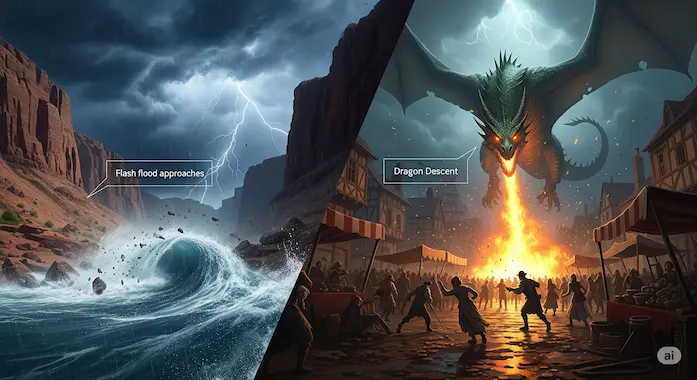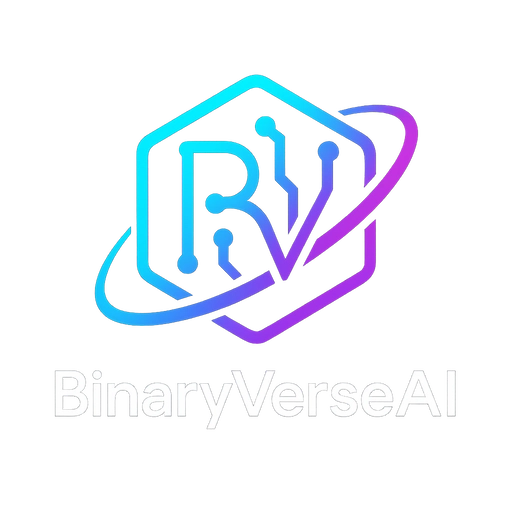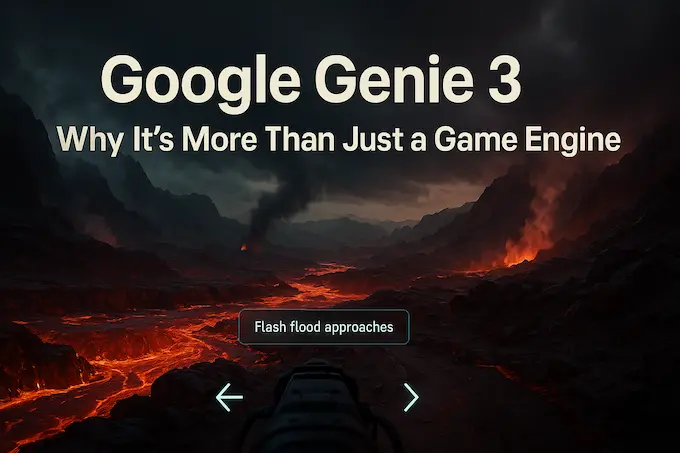1. A New Kind of Launch Day
Some AI releases feel like routine updates, a predictable climb in resolution, speed, or benchmark scores. Then there are the other ones, the rare unveilings that jolt the industry, forcing everyone from hobbyist coders to robotics PhDs to reconsider what’s possible. On August 5, 2025, Google DeepMind dropped one of those rare ones.
It was called Google Genie 3, and it didn’t just generate pretty video clips. It conjured entire worlds you could walk through, poke at, and change on the fly, in real time. At 24 frames per second. At a resolution that finally feels native to the human eye. And perhaps most importantly, it remembered what it had already created, preserving consistency across minutes of gameplay-like interaction.
You could type “navigate a volcanic wasteland in first-person,” and a moment later, you’d be steering a wheeled robot past pools of lava, watching the smoke curl exactly where it should. No pre-built map, no hand-coded physics engine, just a world model AI spinning up a coherent slice of reality from nothing but your prompt.
This wasn’t just another “cool demo.” It was a signal, one that the simulation frontier has shifted, and the path to AGI simulation just got a fresh layer of asphalt.
Table of Contents
2. What Exactly Is a World Model AI?
To appreciate why Genie 3 matters, you need to understand the difference between what most AI systems do today and what world models are built to do.
- Large Language Models like ChatGPT or Claude model the structure of language. They can hold a conversation or write a story, but they don’t track persistent objects or physics. If you say you knocked over a vase in one paragraph, they might “forget” it exists in the next.
- Image Generators like Midjourney or DALL·E model light, texture, and style, but each image is a frozen instant. They don’t simulate cause-and-effect across time.
- World Models, like Genie 3, go further. They simulate environments as dynamic systems. When you walk away from a landmark and come back later, it’s still there. They maintain object permanence, track interactions, and keep physics in play.
In other words, world models don’t just make pixels, they make rules and keep those rules consistent. That’s the secret ingredient for anything that needs to learn or act within a realistic space, from a self-driving car in training to a humanoid robot figuring out how to pour coffee.
3. The Evolution: Genie 3 vs Genie 2 vs Veo
Google’s Genie line didn’t start here. Genie 1 and Genie 2 were already playing in the simulated environment space, but they had limitations: shorter interaction times, less consistency, and narrower control options. Alongside them, DeepMind’s Veo models pushed photorealistic video generation, with Veo 3 showing off uncanny physics-aware rendering.
Genie 3 fuses the two threads, Veo’s realism and Genie’s interactivity, into something qualitatively different.
Here’s the quick comparison:
| Feature | GameNGen | Genie 2 | Veo | Genie 3 |
|---|---|---|---|---|
| Resolution | 320p | 360p | 720p to 4K | 720p |
| Domain | Game-specific | 3D Environments | General | General |
| Control | Game-specific | Limited keyboard/mouse | Video-level description* | Navigation + Promptable world events |
| Interaction Horizon | Seconds | 10–20 seconds | 8 seconds | Multiple minutes |
| Interaction Latency | Real time | Not real time | N/A | Real time |
*Veo allows extra style and camera control in prompts.
The leap from Genie 2 to Genie 3 isn’t just quantitative (longer, sharper, faster). It’s qualitative. Genie 3 introduces promptable world events, a way to inject changes into the environment mid-simulation. You could be hiking through a forest and decide, with a single text command, to make it start snowing or summon a pack of wolves. The world reacts. Physics adjusts. The scene continues without jarring resets.
4. Why Real-Time Changes Everything
Making a simulated world look good is one thing. Making it interactive in real time is another. Genie 3’s architecture generates each frame auto-regressively, meaning it looks at what came before, remembers the relevant details, and decides the next frame accordingly. The kicker: it has to do this multiple times per second while responding to user input.
That’s why a demo of walking down a coastal road in hurricane conditions feels so gripping — the waves keep slamming the railing in rhythm, the palm trees keep bending in believable arcs, and your raincoat stays plastered to your body in the wind. The model isn’t just repainting a scene; it’s running a living simulation you can push against.
For robotics and AGI simulation, this is huge. You can train agents in environments that behave like the real world, but without the cost, danger, or logistical nightmares of physical trials. Want to teach a robot to climb stairs, dodge puddles, or navigate uneven terrain? Spin it up in Genie 3 and let the agent learn from trial and error at scale.
5. Promptable World Events: The Fun and the Frontier

This is where Google Genie 3 stops feeling like a research paper and starts feeling like a toy box for creators. Promptable world events let you alter the simulation on the fly, mid-session, with natural language.
Imagine:
- You’re in a desert canyon. You prompt, “Flash flood approaches.” The sky darkens, water surges in, debris swirls.
- You’re in a medieval marketplace. You prompt, “A dragon lands on the main square.” The crowd scatters, merchants dive for cover, the dragon roars.
For AI research, these events are more than spectacle. They enable “counterfactual” scenarios, the what-ifs that stress-test agents. How does a warehouse robot handle sudden obstacles? How does a self-driving car AI adapt to a downpour? World events let you throw curveballs in a controlled way.
6. Consistency Over Minutes

Anyone who has toyed with procedural generation knows the bane of inconsistency. Walk away from a generated tree, come back, and suddenly it’s three meters taller and a different species. Genie 3 tackles this with emergent consistency, the ability to keep details intact over a longer horizon without explicitly storing a 3D map.
In testing, Genie 3 maintained visual memory up to a minute back, which in simulation time is significant. This means a door you opened stays open, a car you parked remains in place, and a paint job you started is still there when you return.
That consistency isn’t just aesthetic, it’s the glue that makes a simulation a place, not just a loop of stitched-together frames.
7. Genie 3 in Embodied Agent Research
If you spend time in robotics forums, you’ll notice one refrain: “Simulation is cheap, the real world is expensive.” Robots break, sensors drift, batteries die, and indoor labs rarely mimic windy streets or slick factory floors. Training in a world model AI like Google Genie 3 changes that math.
Google DeepMind dropped its SIMA agent into a Genie 3 warehouse and asked it to reach bright forklifts or trash compactors. The bot succeeded because the world stayed put, physics obeyed gravity, and collision boxes behaved. Agents could plan instead of flailing. For once, training loops looked like learning, not a Monty Python skit.
A few practical wins:
| Research Task | Old Pipeline (Weeks) | Genie 3 Pipeline (Hours) | Upshot |
|---|---|---|---|
| Stair-climbing gait tuning | 2 | 6 | Faster hardware roll-out |
| Warehouse route optimization | 3 | 8 | Reduced on-site accidents |
| Drone wind-shear adaptation | 4 | 10 | Safer outdoor autonomy |
| Hand-eye calibration for pick-and-place | 1 | 3 | Lower scrap rates in factories |
The numbers are hypothetical, yet they track with internal reports from labs already swapping Unity scenes for generative interactive environments spun up by Google DeepMind Genie. Time saved equals money saved. Money saved equals more experiments. More experiments equals better robots. The loop accelerates.
8. Three Game-Changing Implications of Genie 3
8.1. The Future of Play

For game studios, Google Genie 3 is the first credible AI game engine. You prompt a medieval town, set guard patrols, adjust market day crowds, and hit play. Want an eclipse? Type it. Need a dragon at dusk? Prompt it. Designers stop wrestling with asset pipelines and start orchestrating stories. Players become co-authors. “Modding” takes on new meaning when anyone can rewrite the laws of in-game physics in a chat box.
8.2. A Training Ground for Real-World Machines
Every AGI simulation demo to date has hit the wall of realism. Robots that succeed in MuJoCo still trip on a toddler’s toy. Genie 3’s real-time, minute-scale coherence moves the line. A Boston Dynamics Atlas could rehearse warehouse tasks overnight, then walk into the actual building with muscle memory already baked. Self-driving algorithms could rehearse rare snow squalls or jaywalking deer by toggling promptable world events. When liability lawyers demand proof of due diligence, engineers will point to terabytes of Genie 3 scenario logs.
8.3. An Imagination Layer for Artificial General Intelligence
Humans game out futures before acting. We picture the coffee mug sliding if we bump the table. An AI needs the same “mental simulator” to become broadly competent. Google Genie 3 delivers the scaffolding. Large language models bring reasoning. Vision models bring perception. Fuse them with a persistent world model and you get a stack that can think, see, and imagine. That is why insiders mutter that Genie 3 is less a product release and more a dress rehearsal for the next chapter of general intelligence.
9. The New Fault Line: Genie 3 vs the Gaming Establishment
Picture a fault line running straight through game development. On one side stand the titans we know: Unreal Engine and Unity. On the other side rises the upstart Google Genie 3, a world model AI that generates interactive environments instead of assembling them by hand. Both camps chase immersion, but their philosophies could not be farther apart, and the clash feels like a tectonic shift in how virtual worlds come to life.
9.1 Constructed Reality: Unreal Engine and Unity
Traditional engines earn their reputation through precision and polish. Art teams sculpt every brick, shader experts tune reflections, and level designers sweat over frame-rate budgets and polygon counts. When a designer places an oak tree, it stays rooted until the next patch. That level of control demands long pipelines, asset stores, and rigorous QA sprints. The payoff is a world that looks and feels exactly as intended. The downside is that even the most epic open worlds can feel static once the main storyline ends, because nothing in them truly changes without developer intervention.
9.2 Generated Reality: Google Genie 3
Now consider Google Genie 3, a genuine AI game engine that builds worlds on the fly. You type “sunset festival in a medieval square” and in seconds you’re wandering through winding alleys filled with market stalls, torchlight flicker, and the distant chime of bells. Want rain? Prompt it. Craving dragons? Promptable world events bring mythic beasts into the scene. No hand-crafted assets, no light-map baking, no endless iteration on terrain meshes. Instead, the system trades absolute polish for infinite dynamism and emergent creativity.
9.3 Speed vs. Polish
This contrast is like comparing film photography to instant digital capture. Unreal Engine workflows are deliberate and design-driven while Genie 3 workflows are immediate and experimental. AAA studios will still rely on hand-tuned code to guarantee 120 frames per second on consoles, and indie developers who prize tight narrative beats will script key moments by hand. Yet for anyone who values rapid prototyping, procedural variety, or scale without a ten-person art team, Google Genie 3 feels like a cheat code for creativity.
9.4 What Happens Next
Will traditional engines adopt world-model plug-ins? Will Google DeepMind license Genie 3 tech to studios craving procedural depth? The only certainty is that we just gained a second axis of competition: polish versus possibility. As the ground shifts beneath virtual feet, developers and players alike will watch to see which side of the fault line defines the future of immersive worlds.
10. Limits and Open Questions
Credible reporting beats hype when it admits friction points. Google Genie 3 still has several.
- Action Space Ceiling. Agents can walk, look, and bump things, but fine-grained hand articulation is missing.
- Multi-Agent Choreography. One robot is easy. Ten with conflicting goals? The simulation jitters.
- Duration. Sessions last a few minutes. Industrial training may need hours.
- Geographic Fidelity. Generating “Downtown Tokyo 1:1 scale” remains out of scope.
- Readable Text. Unless you seed the world description with specific glyphs, signs blur.
DeepMind staff hint that Genie 4 will push toward longer horizons, richer action vocabularies, and sharper typography. They also tease better memory compression so the model can remember past half an hour without ballooning compute bills.
11. Responsibility and Safety
Open-ended generative interactive environments raise risk flags. Malicious prompts could spawn disinformation playgrounds. Unfiltered physics tweaks might normalize unsafe behaviors. DeepMind addresses this by gating early access, layering content filters, and logging every prompt for audit. Critics will still fret, and they should. A sandbox this powerful needs a lifeguard.
In practice, the bigger near-term issue is misuse of simulated data. If a startup trains a forklift bot only in Genie 3 and skips real-world fine-tuning, accidents may follow. Regulators will need new checklists that distinguish simulation coverage from reality coverage.
12. The Road Ahead
Imagining Genie 3 vs Genie 2 a year from now is like comparing a modern smartphone to the Nokia brick. By 2026, expect:
- Multi-hour Consistency. Long-form quests with day-night cycles.
- 4K Real-Time Output. Streaming-quality visuals without render farms.
- Procedural NPC Minds. Language models embedded in agents that live inside the simulation.
- Tactile Feedback Hooks. Haptics so VR gloves feel heat when your volcano adventure gets too close to lava.
If that sounds bold, remember how quickly text-to-image sprinted from 256-pixel blobs to magazine covers. World models will run the same curve.
13. Conclusion: Reality, Editable
Most tech milestones feel incremental when viewed from the inside. Google Genie 3 is different. It hands creators a console where the world is the prompt, not the final image. It weaves memory, physics, and storytelling into a single canvas that listens and responds.
For gamers, it’s a playground that grows with every line you type. For roboticists, it’s a thousand crash-test labs that never close. For AI researchers, it’s a missing puzzle piece on the road to systems that can reason and imagine.
Over twenty years ago, a DeepMind agent found the legendary Move 37 in Go, proving machines could invent strategies humans missed. Google Genie 3 feels like the spatial counterpart to that moment. It’s not one clever move, it’s an entire board springing to life, waiting for the next unheard-of tactic.
Keep an eye on your prompt bar. The distance between an idea and an interactive reality has never been shorter, and the engine shrinking that gap is called Google Genie 3.
Azmat — Founder of Binary Verse AI | Tech Explorer and Observer of the Machine Mind Revolution.
Looking for the smartest AI models ranked by real benchmarks? Explore our AI IQ Test 2025 results to see how today’s top models stack up. Stay updated with our Weekly AI News Roundup, where we break down the latest breakthroughs, product launches, and controversies. Don’t miss our in-depth Grok 4 Review, a critical look at xAI’s most ambitious model to date.
For questions or feedback, feel free to contact us or browse more insights on BinaryVerseAI.com.
What is Google Genie 3?
Google Genie 3 is a real-time, general-purpose world model AI developed by Google DeepMind. It can generate fully interactive 3D environments from simple text prompts, maintaining consistent physics and object memory for several minutes. Unlike traditional engines that rely on hand-built scenes, Genie 3 dynamically creates immersive virtual worlds in real time, making it a foundational tool for gaming, simulation, and AGI research.
How is Genie 3 different from an AI video generator?
Google Genie 3 is a real-time, general-purpose world model AI developed by Google DeepMind. It can generate fully interactive 3D environments from simple text prompts, maintaining consistent physics and object memory for several minutes. Unlike traditional engines that rely on hand-built scenes, Genie 3 dynamically creates immersive virtual worlds in real time, making it a foundational tool for gaming, simulation, and AGI research.
How is Genie 3 different from an AI video generator?
While AI video generators like Veo or Sora create short, passive clips, Genie 3 builds interactive environments you can move through and influence in real time. It doesn’t just generate visuals, it simulates a world with physics, memory, and responsiveness. This makes Genie 3 not just a video tool, but a fully operational AI game engine capable of real-time interaction and procedural storytelling.
Can I try or download Google Genie 3?
Currently, Google Genie 3 is available only as a limited research preview. Google DeepMind has not released a public version or download link yet. Access is restricted to select academic partners and creators, but broader availability may roll out in the future as the technology matures and safety measures are refined.
What is a “world model” in AI?
A world model in AI refers to a system that simulates an environment with rules, physics, and memory. Unlike language or image models, world models can predict how objects behave over time, enabling embodied agents or robots to learn by interacting with a dynamic virtual world. This technology is a key component in the development of AGI simulations and autonomous systems.
Will Genie 3 replace game engines like Unreal Engine?
Genie 3 won’t replace Unreal Engine or Unity overnight, but it introduces a new paradigm in game development. Traditional engines rely on handcrafted assets and scripted interactions, while Genie 3 enables generated reality, worlds created and changed on the fly with simple prompts. Developers looking for speed, creativity, and large-scale procedural content may see Genie 3 as a powerful alternative or complement to traditional tools.

